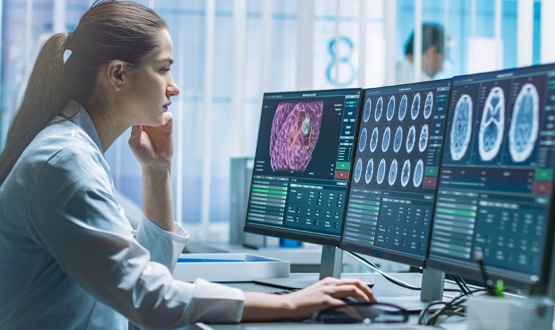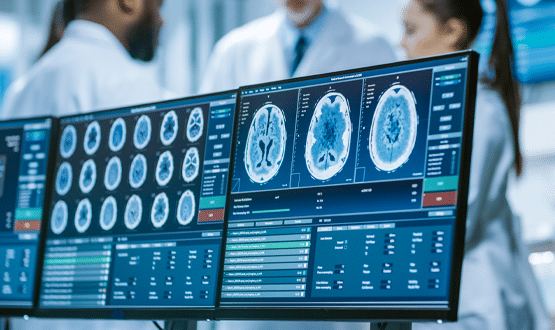EHI Awards 2012: Look, no CDs
- 26 October 2012

Picture archiving and communications systems undoubtedly revolutionised the capture and storage of clinical images by replacing costly and labour-intensive analogue methods. But there hasn’t been quite the same revolution when it comes to sharing those images.
Indeed, sharing electronic imaging outside PACS can be more challenging than it was when x-rays and prints were the only technology available, since technicians have to burn images to CD or DVD – sometimes from different imaging systems – before dispatching them by courier or post to another hospital.
Cost, too, can be an issue. At £12.50 a throw, posting disks tots up to a tidy annual sum for a busy hospital or clinic; while shipping them long distance by cab can mean a (financial) arm and a leg.
Worse still, the use of physical media risks delays and data loss. And when disks do finally arrive, the information must be transferred to the clinician’s workstation before it can be viewed. What’s more, if colleagues in different locations need to confer, each requires a CD.
Enter the Image Exchange Portal
In 2010, the Department of Health took the first step toward solving these issues by deploying an Image Exchange Portal service. This replaced the need for physical media with a secure web-based system, enabling trusts and independent providers to load and share clinical images and reports.
“This not only reduced the cost and risk of data being lost in transit, but also speeded up the transfer of images between clinicians, thereby improving collaboration between multi-disciplinary teams,” says Steve Jessop, technology and implementation manager at Burnbank Systems, who developed the service on behalf of the DH.
“Working alongside PACS, the IEP quickly became embedded within the day-to-day workflow of the NHS and changed the way trusts and independent healthcare providers operate,” he says. “Even more significant has been its positive impact on patient care, the key driver behind the initiative.
“By engaging with end users and the clinical community, we’re continually improving the service to ensure it meets and exceeds expectation – not only in streamlining radiology reporting and improving patient care, but also in enabling better information governance and clinical safety than with traditional image transfer methods.”
Such was the uptake of the service within the NHS – reflected in the rapid growth of connected sites, data volumes and registered users – that Burnbank was soon encouraged to extend the IEP to enable image transfers directly between trusts via the N3 network or virtual private network links to the internet.
“Having originally envisaged that the IEP would transfer around 550 studies per day, it now regularly handles over 7,000 studies each day; and 900 per hour at peak periods,” Jessop says. “And it does all that with an average delivery time of less than 30 minutes. Using VPN links, moreover, authorised clinicians can now view medical images remotely and from home.”
IEP in action
Jessop says the IEP is helping trusts comply with NICE guidelines, in particular where rapid diagnosis and early management are essential.
“For instance, outcomes for stroke patients are dramatically improved if treatment begins within 48 hours of symptom onset. IEP is allowing specialist networks – like the Cumbria and Lancashire Telestroke Network – to access images quickly and remotely out-of-hours, enabling early stage intervention.”
Working across six acute trusts with different PACS systems, this network provides out-of-hours consultants to help local teams decide when stroke patients might benefit from thrombolysis, according to Dr Paul Davies, consultant stroke physician at North Cumbria University Hospitals NHS Trust.
“The purpose of the network is to enable realtime, two-way audio-visual patient assessment and CT image review,” he says.
“The IEP now provides us with a simple, elegant out-of-hours solution involving one interface and one password that each stroke consultant can access. It has become an integral part of our network and has so far contributed to an extra 100 patients in Cumbria and Lancashire receiving thrombolysis for acute stroke.”
Jessop says the service is being used in a similar way by trauma and cardiac networks to transfer images for specialist review in other hospitals.
“It is proving invaluable in cases where patients are too ill to travel but need specialist care,” he says. “And where patients are transferred between sites, their images usually arrive before them.”
Reduced overheads
By reducing re-imaging and enabling faster referral decisions, the IEP has also brought savings for some trusts. Phil Lindley, PACS project manager at University Hospitals of Coventry and Warwickshire NHS Trust, an early IEP adopter, says the service has proven cost-effective in distributing radiological images and reports.
“It provides a complete end-to-end solution for sending and requesting images across the country and is both adaptable and configurable, supporting the workflow of many different departments,” he says. “Transfer times have been reduced significantly over the traditional process of burning CDs and using special delivery services.
“The IEP is also intuitive, thereby reducing training overheads. What’s more, any issues we have – which are very few and far between – are quickly dealt with by knowledgeable and friendly helpdesk staff,” he adds.
Wider adoption
The IEP now links the majority of PACS systems nationwide and manages the integration of different standards, says Jessop. “We’ll continue expanding functionality to allow integration with RIS and other hospital systems where HL7 messaging is used to provide electronic transfer of clinical information.”
With most trusts in England, Scotland and Wales now connected, he says the IEP is now reaching into everything from community health to teleradiology.
“For instance, a medico-legal module supporting image transfer for medical research and teaching is currently being evaluated by several trusts to provide cost savings by further reducing the use of CDs, as well as improving workflow and data security.
“We’re also working on integration with new thin client viewing technology that provides rapid access to detailed imaging to support emerging healthcare workflows and an increasingly mobile patient community.
“Our special emphasis on end-user support will also ensure that the IEP service continues to provide a greater range of clinical services whilst adapting to the changing healthcare economy,” he concludes.

The EHI Awards 2013 in association with CGI are now open for entries. For full details of this year’s categories, judging process and how to submit your entry please visit the dedicated awards website.
This year’s black tie awards dinner will be held at the prestigious Roundhouse in north London on 10 October. For information about sponsorship opportunities contact head of events Neil Hadland. Tickets will also be on sale soon.




